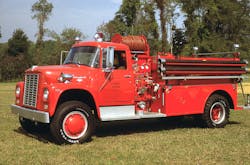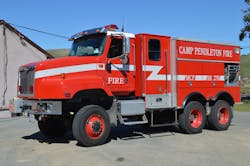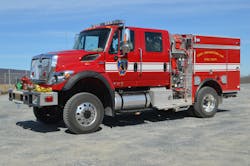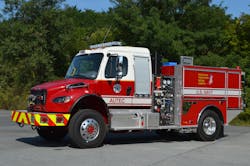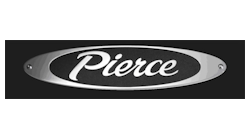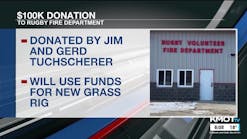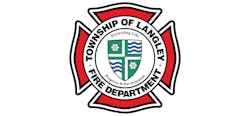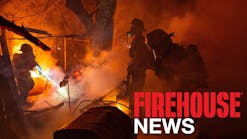Many military installations face wildland fire challenges that aren’t that dissimilar from what municipal fire departments face in the protection of the wildland urban interface. Agencies that are within the Department of Defense, including the U.S. Army, the U.S. Air Force, the U.S. Marines and the U.S. Navy, all operate different types of wildland apparatus to protect the military and civilian assets at installations.
Over the years, wildland vehicles evolved from modified military truck platforms to today’s custom-built apparatus that are acquired to meet the specific missions at each installation based upon topography, type of vegetation and access to mutual aid to mitigate large-scale incidents.The Marines
Early wildland apparatus consisted of locally modified 2½-ton International M5H-6 cargo trucks, which were equipped with a separate engine-driven fire pump, a 500-gallon water tank and twin booster reels, which provided off-road capability. Several manufacturers produced model 530B structural pumpers, which were utilized for both structural and wildland fire protection and were equipped with a 500-gpm fire pump, a 400-gallon water tank, and a 40-gallon Class B foam tank and system. Several of these units were modified for off-road wildland incidents via the addition of larger water tanks and handlines.
The Marine Corps Base at Camp Pendleton, CA, has a long history of wildland fire protection given the terrain and ordnance hazards that are encountered at the 125,000-acre installation. The department staffs 10 fire stations along with a seasonal wildland station that has an extensive fleet of wildland apparatus.
The first generation of the wildland apparatus were built using a Kaiser M813A1 5-ton military chassis that was modified via the installation of a diesel-driven, 100-gpm-rated auxiliary pump, an 800-gallon water tank and a 50-gallon Class A foam tank. Unique heavy steel roll bars were built to protect the crews. These vehicles had almost unlimited off-road capability and, with the floating water tank cradle, enjoyed excellent gradeability.
Over the years, Camp Pendleton Fire operated approximately 16 different models of these heavy brush trucks.Beginning in 1999, in an effort to provide better protection for the crew, Camp Pendleton placed into service several heavy Type 3 rigs that were built by Boise Mobile Equipment. The rigs were built using an International Paystar 6x6 chassis that had an enclosed crew area built into the body. These units were equipped with an diesel-driven, 80-gpm auxiliary pump, an 800-gallon water tank and a 20-gallon foam tank. These rigs became the basis for future tandem-axle wildland rigs for use in the Marine Corps Fire Service.
Today, Camp Pendleton operates a mixture of Type 3 and Type 6 vehicles in its fleet, including several tandem-axle 6x6 rigs that are equipped with a 250-gpm pump, an 800-gallon water tank and Class A foam system. Enhanced compartment and hose storage space is included. These rigs are complemented by single-axle Type 3 vehicles that are outfitted with both a fixed 500-gpm pump and a diesel-driven auxiliary pump for pump-and-roll operations as well as several Type 6 units that use a 19,500-lb. GVWR, two-door, four-wheel-drive chassis that’s outfitted with a 200-gallon water tank and 120-gpm fire pump.
The Air Force
The Air Force wildland vehicle fleet includes several Type 3 models that are built with an International four-door cab and are outfitted with a 500-gpm fixed pump, a diesel-driven, 180 gpm auxiliary pump, a 500-gallon water tank and a 40-gallon Class A foam tank. Several Type 6 units that were built to the New Jersey Forest Service specifications operate at Joint Base McGuire-Dix-Lakehurst.
The Air Force developed specifications for the different models of their structural, ARFF and wildland apparatus.The Army
Over the years, the Army utilized different platforms for wildland fire protection. That began in 1966 with the delivery of several International four-wheel-drive units that were equipped with a 500-gpm pump and a 600-gallon water tank. The rigs included a single booster reel and a front brush guard. Several of these models were acquired by the Navy, but they suffered from low ground clearance and were replaced with the GMC 7500 four-wheel-drive rigs that featured a higher ground clearance, enclosed body compartments with crosslay hose beds and a 400-gallon water tank with an around-the-pump foam system.
When compared with today’s four-wheel-drive chassis, vehicles of this era that had front-driving axles had a wide turning radius and limited factory-provided options for integration for fire service applications. Many of today’s commercial chassis that are utilized for wildland apparatus, including Freightliner and International models, can be supplied with safety-related components, such as air bags, a collision-avoidance system and electronic stability controls. Other equipment, such as vehicle data recorders, fire curtains and cab gear compartments, are supplied as detailed in the technical specifications for each vehicle.
The Army recently placed into service a number of Type 3 wildland vehicles that were built by Pierce Manufacturing on an International HV-507 on a 183-inch wheelbase and are powered by a Cummins L9 engine that’s rated at 350 hp and an Allison EVS 3000 automatic transmission. The rigs are equipped with a Darley JPM pump that’s rated at 500 gpm and a Darley 1.5 AGE-24 diesel-driven auxiliary fire pump that’s supplied by a 500-gallon water tank. A single-agent foam system and a 20-gallon Class A tank are provided, along with a booster reel that’s equipped with 150 feet of 1-inch hose and a remote-controlled bumper turret that has a variable gpm automatic nozzle. With an overall length of 25 feet, 10 inches, these rigs are very maneuverable. There’s seating for four personnel. An aluminum body has seven enclosed body compartments.The Navy
Several years ago, Navy Fire and Emergency Services developed specifications for a multipurpose vehicle that could provide both structural and wildland protection. The rig can be used as a rapid intervention vehicle for outlying airfields for ARFF protection. The initial design called for a dual-pump system that includes a 500-gpm pump for stationary applications (supplying a crosslay hosebed and 2½-inch discharges) along with a UHP pump that supplies both a booster reel and front-bumper turret. These units were built with a 500-gallon water tank and a 50-gallon Class B foam tank on a two-door extended-cab chassis that has a wheelbase of 184 inches and an overall length of 26 feet, 6 inches. Equipment carried included a 100-lb. dry-chemical system, a 150-foot hose reel, a 16-foot extension ladder, hydraulic rescue tools and portable fire extinguishers.
Other variants of these multipurpose vehicles included a four-door cab, a 750-gallon water tank and hydraulically driven auxiliary pumps to support both stationary and pump-and-roll operations. The chassis for these rigs were built on a longer 207-inch wheelbase, with an overall length of 29 feet, 6 inches. To keep the hosebed low to the ground and to maintain the center of gravity with the larger water tank, a 140-inch-long body was utilized, providing for three compartments on each side of the body, along with a hinged-door rear-body compartment.
Flexibility of design
Developing specifications for wildland apparatus requires flexibility, to ensure that each model of apparatus meets the designated mission for the vehicle as well as provides adequate room for the crew, gear and equipment that must be carried on the unit.
Unlike structural engines, which operate on relatively short-duration incidents, wildland apparatus must be capable of operating at incidents that might be long distances from the station and of providing the resources that are needed for extended operations at remote locations. This is one of the reasons why you see a fair amount of standardization on Type 3 units, which can be assigned as strike teams at large incidents.
Many Department of Defense installations participate in mutual-aid agreements, for which their wildland apparatus can be deployed as needed at large-scale wildland incidents, where operational procedures and apparatus components are standardized and practiced by all agencies.

Tom Shand
TOM SHAND, who is a Firehouse contributing editor, is a 36-year veteran of the fire service. He works with Michael Wilbur at Emergency Vehicle Response, consulting on a variety of fire apparatus and fire department master-planning issues. Shand is a member of the Firehouse Hall of Fame.

